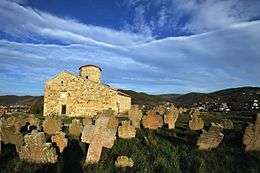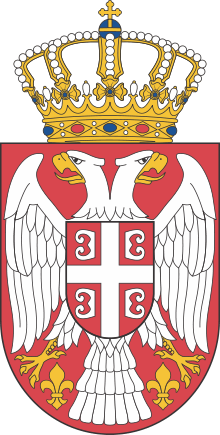Raška (region)
| Raška | |
|---|---|
| Historical region of Serbiaa | |
 Raška (without northern Montenegro and parts in Kosovo region) and other geographical regions in Serbia | |
| Country |
|

Raška (Serbian Cyrillic: Рашка) or Old Raška (Serbian: Стара Рашка/Stara Raška) is a region in south-western Serbia, Kosovo and northern Montenegro. In the Middle Ages, the region was a center of the Serbian Principality and of the Serbian Kingdom whose capital was once the city of Ras (a World Heritage Site) until 1265. In the Early Middle Ages, it had parts of present-day southern Serbia, Kosovo, northern Montenegro, eastern Herzegovina. It has given its name to the Raška municipality and town and Raška District.
Geography
Sub-regions
- Stari Vlah (Стари Влах, pronounced [stâːriː vlâx]) is part of Priboj, Nova Varoš, Prijepolje, Užice, Čajetina, and Arilje, which is part of the Zlatibor District, and Ivanjica, which is part of Moravica District.
- Pešter
- South Podrinje
- Raška (river)
- Sjenica Field
- Rujno
- Zlatibor
- Pljevlja Field
- Nadibar
- Dragačevo
- Ibarski Kolašin
Name

The name is derived from the name of the region's most important fort, Ras which first appears in the work de aedificiis of Byzantine Procopius as Arsa prior to the forming of Serbia (Procopius, De aedificiis, IV 4). Ras eventually became the capital district and seat of the first bishopric of Serbia (the Eparchy of Raška and Prizren).
The name of the bishopric eventually started to denote the entire area under jurisdiction and later, under Stefan Nemanja, Ras was re-generated as state capital and as such it has at times been used by some in historiography to refer to Serbia from the early 12th to the early 14th century. It had begun its use as an exonym for Serbia in Western European sources in the early 13th century, along with other names such as Dalmatia and Slavonia.
The first attested appearance of the name Raška is in the Kotor charter (1186), in which Stefan Nemanja is mentioned as župan of Raška. Soon after Raška (Rascia) became an exonym for Serbia in western sources (Papacy, German, Italian, French etc.) often in conjunction with Serbia (Servia et Rascia). However, that name appears scarcely in medieval Serbian and never in Byzantine works to denote the state.
Between the 15th and 18th centuries, the term Raška (Rascia, Ráczság) was used to designate the southern Pannonian Plain inhabited by Serbs (Raci), who settled there during the late Middle Ages, the Ottoman period and the Great Serb migrations from medieval Serbia, "Rácz" has survived as a common surname in Hungary.
History
Middle Ages
Raška (in Latin Rascia) was a medieval region that served as the principal province of the Serbian realm. It was an administrative division under the direct rule of the monarch and sometimes as an appanage. The term has been used to refer to various Serbian states throughout the Middle Ages. It was the crownland, seat or appanage of the following states:
- Serbian Principality (768-960), crownland; seat of state and religious see (Eparchy of Raška and Prizren)
- Catepanate of Serbia and Theme of Sirmium (960-1043), Byzantine province
- Grand Principality of Duklja (1043-1101), crownland; appanage
- Serbian Grand Principality (1101-1217), crownland
- Serbian Kingdom (1217-1345), crownland
- Serbian Empire (1345-1371), crownland
- Serbian Despotate, crownland
In Constantine Porphyrogenitus' De Administrando Imperio, Ras is mentioned as an important town of Serbia under Časlav Klonimirović (927–960) near its border with the First Bulgarian Empire. Constantine's Serbia is often identified as Raška by modern historiography to differentiate it from the other provinces ruled by these early Serbs: Zahumlje, Travunia, Duklja and Pagania. Porphyrogenitus uses Serbia as a name for the mainland regions of Rascia and Bosnia; although the name comes to denote "all of Serbian lands" as an exonym.
Modern
Between 1918 and 1922, Raška District was one of the administrative units of the Kingdom of Serbs, Croats and Slovenes. Its seat was in Novi Pazar. In 1922, a new administrative unit known as the Raška Oblast was formed with its seat in Čačak. In 1929, this administrative unit was abolished and its territory was divided among three newly formed provinces (banovinas). The region is a part of the greater "Old Serbia"-region used in historical terms.
Culture
Some of the churches in western Serbia and northeastern Bosnia were built by masters from Raška; they include:[1] Stari Ras, Church of the Holy Apostles Peter and Paul, Ras, Raška architectural school, Gradac Monastery, and Stara Pavlica.
See also
References
- ↑ Janićijević, Jovan (1998). The cultural treasury of Serbia. p. 147.
Sources
- Bataković, Dušan T., ed. (2005). Histoire du peuple serbe [History of the Serbian People] (in French). Lausanne: L’Age d’Homme.
- Ćirković, Sima (2004). The Serbs. Malden: Blackwell Publishing.
- Ćorović, Vladimir (2001). Istorija Srpskog Naroda [History of the Serb People] (in Serbian) (Internet ed.). Belgrade: Ars Libri.
- Gigović, Ljubomir. "Etnički sastav stanovništva Raške oblasti" (PDF). Globus 2008, vol. 39, br. 33, str. 113-132. Београд. Archived from the original (PDF) on 2014-05-06.
- Kalić, Jovanka (1979). "Naziv Raska u starijoj srpskoj istoriji (IX-XII vek)". Zbornik Filozofskog fakulteta, XIV-1 (Belgrade, 1979), pp. 79-91.
- Kalić, Jovanka (1995). "Rascia - The Nucleus of the Medieval Serbian State". Rastko. Archived from the original on 2014-01-15.
- Petrović, Milić F. (2007). "Raška oblast u Jugoslovenskoj državi 1918-1941". Časopis Arhiv – godina VIII broj 1/2. Beograd.
- Whittow, Mark (1996). The Making of Byzantium, 600–1025. MacMillan Press. ISBN 0-520-20496-4.
- Fine, John Van Antwerp (1991), The Early Medieval Balkans: A Critical Survey from the Sixth to the Late Twelfth Century, University of Michigan Press, ISBN 978-0-472-08149-3
- Hupchik, Dennis P. (2002), The Balkans. From Constantinople to Communism., Palgrave MacMillan, ISBN 1-4039-6417-3
- Stephenson, Paul (2003), The Legend of Basil the Bulgar -Slayer, Cambridge University Press, ISBN 0-521-81530-4
- Curta, Florin (2006). Southeastern Europe in the Middle Ages, 500–1250. Cambridge: Cambridge University Press.
- Moravcsik, Gyula, ed. (1967) [1949]. Constantine Porphyrogenitus: De Administrando Imperio (2nd revised ed.). Washington D.C.: Dumbarton Oaks Center for Byzantine Studies.
- Samardžić, Radovan; Duškov, Milan, eds. (1993). Serbs in European Civilization. Belgrade: Nova, Serbian Academy of Sciences and Arts, Institute for Balkan Studies.
- Whittow, Mark (1996), The Making of Byzantium, 600–1025, MacMillan Press, ISBN 0-520-20496-4
- Живковић, Тибор (2002). Јужни Словени под византијском влашћу 600-1025 (South Slavs under the Byzantine Rule 600-1025). Београд: Историјски институт САНУ, Службени гласник.
- Živković, Tibor (2008). Forging unity: The South Slavs between East and West 550-1150. Belgrade: The Institute of History, Čigoja štampa.
- "Political developments and unrests in Stara Raška (Old Rascia) and old Herzegovina during Ottoman rule" (PDF). Balcanica.
- Proroković, D., 2014. Raška oblast kao geopolitičko žarište i njen značaj po položaj Srbije i Srpske /Raska region as a geopolitical hot spot and its significance for the position of Serbia and Srpska. Politeia, 4(7), pp.175-193.
External links
| Wikimedia Commons has media related to Rascia. |

